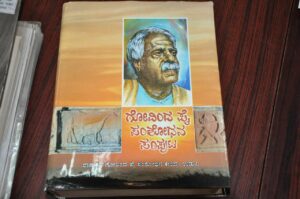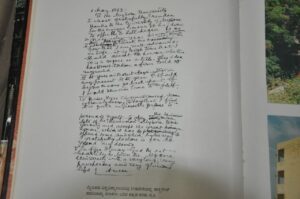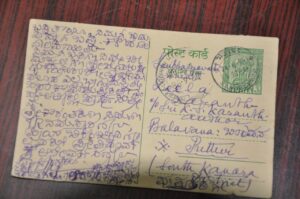By writing this poem about the most important religious figure of a foreign-born religious text, he established himself not simply as the Rashtrakavi but also as the kavi of world peace. It is equally important to note that Govinda Pai, in his position as a historical researcher, was fully aware of the forced conversions and the atrocities perpetrated by the Portuguese on his Konkani-speaking forefathers. But the poet of 'Golgotha' held no prejudices or preconceived notions.

(L) A picture of M Govinda Pai, some years after he was given the title of Rashtrakavi; (R) The front cover of his book 'Golgotha' ( Muraleedhara Upadhya Hiriadka)
The Kannada poet M Govinda Pai was famous for his research work in the fields of history and literature.
In 1995, the Govinda Pai Samshodhana Kendra (Govinda Pai Research Centre) in Udupi brought out the mammoth “Govinda Pai Research Volume” totalling 1,392 pages. The book is set to see a reprint this year.

A copy of the 1,392-page Govinda Pai Research Volume, edited by the author of this article (Muraleedhara Upadhya Hiriadka)
Govinda Pai, who joined the Madras Christian College to do his BA, secured the first rank in the university for English besides bagging the gold medal.
One of his classmates was S Radhakrishnan, the future president of independent India.
In the Govinda Pai Grantha Bhandara in Udupi, which houses the entire collection of his books, there are 4,734 books in 36 languages.
Govinda Pai himself wrote in Kannada, English, and Konkani (which, incidentally, was his mother tongue).
Besides these languages, Pai was also accomplished in Bengali, Gujarati, Hindi, Latin, Greek, French, Spanish, and Japanese.
As a tribute to Govinda Pai’s creative and scholastic achievements, the Madras government declared him the Rashtrakavi (National Poet) in 1948.
Though he began writing poetry in the old tradition, i.e. using adiprasa or second-syllable rhyme, M Govinda Pai broke away from it in 1911 with the publication of his poem, ‘Holeyanu Yaaru’ (Who is the Holeya).
Pai’s decision to reject the traditional rhyme is of historical importance. His words at the time, “This goat-path I singly tread today will become the highway on which the chariot is pulled”, would turn true not long after.
In those times, Govinda Pai’s home in the town of Manjeshwar in the Kasaragod district was a pilgrimage-site of sorts for Kannada writers. In 1931, the poet Pandeshwar Ganapathi, visiting Govinda Pai in his Manjeshwar home, read out his poem “Krista Janma” (The Birth of Christ).
Impressed by the poem, Pai decided to write a poem about the last days of Christ.
In 1931, Govinda Pai’s “Golgotha Athava Yesuvina Kadeya Dina” (Golgotha or The Last Day of Christ) was published in the Mangaluru newspaper, Svadheshabhimani.
In writing this poem, Govinda Pai relied on the gospels of Matthew, Mark, Luke, and John found in the New Testament of the Bible. A long poem consisting of 377 lines, Kannada critics have labelled this a “Khanda Kavya”, the Kannada equivalent of the English term “epic fragment”.
The word “Golgotha” is an Aramaic word that means “skull”. It is also the name of a hill outside of Jerusalem.
A description of a skull appears near the end of Pai’s poem. Lying beneath the cross on which Jesus has been crucified, the skull is described as looking upon the world and laughing.
The suggestion here is that the skull’s laughter is a laughter meant to hide its tears at having seen how mass hysteria caused by the hatred of an “other” religion can lead to such a bloody event as the killing of Jesus.
Pai’s Golgotha begins with the sentencing of Jesus by Caiaphas. On the morning of the next day, Friday, Jewish religious leaders drag Jesus along and present him to Pontius Pilate, the governor of Judea and representative of the emperor of Rome.
They complain to Pilate about Jesus, saying “This man declares himself to be the king of the Jews and refuses to recognise the authority of the Roman emperor.”
An inquiry shows Pilate that Jesus is innocent of the crime he is being blamed for. At the same time, Pilate’s wife tells him of a dream she had that morning about Jesus and asks Pilate not to punish such a good man.
On the other hand, Jesus’s fellow Jews, in the grip of mass hysteria, are baying for his blood and demanding the death sentence for him.
With an eye to retaining his power, Pilate decides to condemn Jesus to death, despite knowing he is innocent. Asking for a pitcher of water to be brought, Pontius Pilate announces the death sentence for Jesus and then washes his hands with water from the pitcher, saying “I am not responsible for this man’s death.”
Taunting Jesus, the Roman soldiers pull him along to Golgotha, a skull-shaped hill outside of Jerusalem, and hang him up on the cross between two thieves.
From his place on the cross, Jesus forgives all those in the mob who are baying for his blood. Looking on from afar and crying is Mary of Magdala.
It is in the description of the inner conflict of the characters of this epic fragment that Pai’s true poetic genius shines through.
In his rendering, the so-called religious Jews have been gripped by a mass hysteria. While Pilate is prepared to pardon Jesus and let him go, the mob is against it. Both Pontius Pilate and his wife are aware of Jesus’s innocence. However, the fear of losing his authority gnaws at Pilate.
He does not stop to think that his conscience will continue to haunt him even after he has washed his hands. Responding to Pilate, Jesus says, “Mine is the kingdom of truth”. He also cries “Eli, Eli, lama sabachthani”, as he hangs nailed to the cross. It is interesting to note that this is a psalm of David, King of Israel. (Psalm 22:1 to be precise.)
It is also the distressed cry of all innocent and helpless people subjected to persecution on account of religion-driven mass hysteria.
In her turn, Mary of Magdala becomes the representative of all those women in a patriarchal society who look upon helplessly at the fighting brought upon by blind religious belief.

A handwritten letter by Govinda Paid declining the honorary doctorate conferred on him by the University of Mysore (Muraleedhara Upadhya Hiriadka)
It is also worth noting how Govinda Pai describes Jesus’s corpse as hanging on the cross until moonrise. This change is less a breaking of a historical narrative than it is an example of Pai’s felicitous use of poetic license.
Ultimately, Pai’s Golgotha is not a religious poem, it is a worldly poem.
Golgotha reads like a “chapter” of an unwritten epic poem. The chapter is the Chapter of Cruelty, the Chapter of Murder, the Chapter of Compassion.
To get a feeling for the beauty of Pai’s poetry, we would do well to look at some of the similes he uses. Here they are in English translation –
“And Jesus looking
Like a quail in the vulture’s clutches, like slip of the moon
in the west, … like the deathless fruit
on death’s tree”
The Jesus nailed to the cross has become a deathless fruit, an immortal being. Here are the images Pai uses to describe the last moments of Jesus’s life:
“as a young deer
leaps to its mother calling from the hilltop,
Or as a lark darts towards fields of harvest,
Or as lightning soars flashing in the horizon ,
Jesus’ soul sped to the sphere of unsetting suns,
As he rendered his life to his father”
(Translated from the Kannada by K Narasimhamoorthy)
Golgotha ends with a description of the moonlight and with the word “shantam” (which means “peace” in Sanskrit and is often used to conclude devotional verses).
The poetic style used by Govinda Pai’s in Golgotha, a style redolent of the Nadugannada (Middle Kannada) period, comes across like an old-time ornament that attracts the modern sensibility.
It is an important matter that he has written this poem about the most important religious figure of a foreign-born religious text.
By doing so, M Govinda Pai established himself not simply as the Rashtrakavi but also as the kavi (poet-seer) of world peace.
It is equally important to note that Govinda Pai, in his position as a historical researcher, was fully aware of the forced conversions and the atrocities perpetrated by the Portuguese on his Konkani-speaking forefathers.
But the poet of Golgotha held no prejudices or preconceived notions. He was a poet who made it a point to have the symbols of all the world’s religions printed on his brother’s wedding invitation.
He was a poet who, having lost his wife in his middle age, spent the rest of his life dwelling on the mystery of death.
His short epic poems Vaishaki, Prabhasa, and Dehali were about the last days of Buddha, Krishna, and Gandhi respectively. “Yesu-Krishna” is another one of his famous poems.

A letter from Pai to Kota Shivarama Karanth, the great Kannada polymath and Jnanpith awardee (Muraleedhara Upadhya Hiriadka)
The Pai of Golgotha is an anti-war poet.
When The Hindu published an article on 26 February 1943 titled “New Terror in Hiroshima – Shadow of Atom Bomb Explosion”, Pai, who read the article, was inspired to write an anti-war poem titled “Hiroshima”.
In his autobiographical narrative, Pai has said, “I sing mostly when I am suffering”. Yes – written by Pai as he reflected on Jesus’s last day and the suffering he underwent, Golgotha is an unprecedented Kannada poem.
The laughing skull beneath the Golgotha hill is an image that continues to haunt us.
Golgotha is a supreme Kannada poem that deserves to be translated into all India’s languages as well as all the major languages of the world.
(This article is a translation by Madhav Ajjampur of an essay by Prof Muraleedhara Upadhya Hiriadka. Hiriadka was the former head of the Kannada division at Poornaprajna College, Udupi.
He has authored and edited a number of monographs on personalities including MN Kamat, Kayyara Kinhanna Rai, Haji Abdulla Saheb, BV Karanth, and Vaidehi. Among the awards he has received are the Inamdar Vimarsha Prashasti and Jnanadegula Prashasti. A former member of the Sahitya Akademi, New Delhi, he is the editor of the Govinda Pai Samshodhana Samputa. He maintains a Kannada blog. These are the personal views of the author)

Jul 25, 2024

Jul 25, 2024

Jul 25, 2024

Jul 24, 2024

Jul 24, 2024

Jul 23, 2024